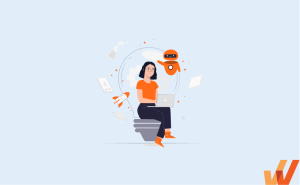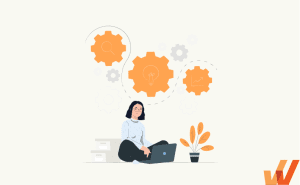As companies invest in digital transformation and technology is adopted faster than employees can adapt, organizations must enable their workforce with continuous learning experiences and upskilling to meet the requirements of their role, improve their performance, grow employees into leaders, and help them advance in their careers.
This reality calls for a fundamental shift in how companies operate their learning and development strategy — a shift toward becoming a more agile learning organization.
According to LinkedIn’s Executive Confidence Report, the C-suite has noticed. In the next six months, 90% of executives plan to increase their L&D budget to focus on upskilling.
In this article, we’ll explore the path to building a learning organization that fosters a continuously evolving culture in the age of digital transformation.
What Is a Learning Organization?
A learning organization is an entity that fosters a culture of continuous learning and knowledge creation at all levels. It is an organizational paradigm that recognizes the importance of adapting to change, acquiring new knowledge, and leveraging insights to improve performance and achieve strategic objectives.
In 1990, author and systems scientist Peter Senge popularized the concept of learning organizations in his book, The Fifth Discipline: The Art & Practice of the Learning Organization.
He described these companies as “where people continually expand their capacity to create the results they truly desire, where new and expansive patterns of thinking are nurtured, where collective aspiration is set free, and where people are continually learning how to learn together.”
5 Characteristics of a Learning Organization
In a learning organization, learning is not limited to formal training programs or individual activities; it becomes an embedded aspect of the organizational culture and processes.
The entire organization is engaged in acquiring, sharing, and applying knowledge, with a focus on innovation, collaboration, and the ability to respond quickly to challenges and opportunities. Learning organizations promote open communication, experimentation, and reflection, valuing the collective intelligence and learning capacity of their employees.
Here are the key characteristics of learning-based organizations.
1. Building a shared vision
A shared vision is a vital characteristic of a learning organization that establishes a common goal and has the power to encourage innovation and creative thinking.
When a vision is created as a team, people feel that their ideas are valued and that they are working towards a common goal.
2. Personal mastery
Personal mastery refers to the individual’s commitment and continuous journey toward personal growth, learning, and self-improvement. It is about cultivating a mindset of lifelong learning and striving for excellence in one’s chosen field or area of expertise. It involves developing self-awareness, honing skills, and fostering a deep sense of purpose and passion for continuous learning. Personal mastery is encouraged in a learning organization as it contributes to the overall collective learning and growth of the organization.
3. Mental models
Mental models are deeply ingrained assumptions, generalizations, or even images that influence how we understand the world and how we take action.
These models can either facilitate or hinder learning and organizational growth. In a learning organization, there is a focus on surfacing and challenging mental models, encouraging individuals to examine their underlying assumptions and biases. By promoting reflection and open dialogue, organizations can foster a culture where mental models are continuously examined, refined, and expanded. This process allows for new perspectives, innovation, and more effective problem-solving, ultimately contributing to the organization’s ability to adapt and learn in a rapidly changing environment.
4. Team learning
Team learning is a collaborative process where individuals within a team come together to actively share knowledge, experiences, and insights to enhance the collective learning and performance of the entire team.
Team learning fosters a culture of collaboration where team members learn from each other, challenge assumptions, and collectively solve problems. By engaging in team learning, organizations can harness the collective intelligence and capabilities of their teams, leading to enhanced problem-solving, innovation, and overall team performance.
5. Systems thinking
Systems thinking in a learning organization entails viewing the organization as a complex and interconnected system where various components, processes, and individuals interact and influence each other.
The idea is to encourage businesses to examine the broader landscape and distinguish patterns instead of conceptualizing change as isolated events.
By applying systems thinking, a learning organization can identify systemic factors that impact learning effectiveness, address root causes of challenges, leverage interconnected elements for improvement, and foster a holistic approach to continuous learning and organizational development.
Related Resources
Where Does Organizational Learning Happen?
In learning organizations, learning is expected, knowledge is easy to find, and employees are told it’s okay to fail (fail quickly and learn from those mistakes.) This means that learning becomes an organization’s cultural pillar and is embedded in all company activities.
Here are the different areas organizational learning takes place at a company that understands the importance of learning and development:
- Individual Learning: This type of learning takes place by a single employee who can seek out additional training and skill development programs through online courses, certificate programs, webinars, case studies, books, etc.
- Group Learning: Also known as team learning, knowledge transfer and skill acquisition happen through group activities and social learning experiences, like job mentoring, lunch and learns, and other team-centric learning exercises. Group members can share personal knowledge and how it applies to their contextual team’s tasks and responsibilities and can spark conversation, debate, and feedback.
- Organizational Learning: This includes organizational-wide learning opportunities like upskill training programs, bringing in guest speakers, subscriptions to online learning platforms, access to higher education opportunities, etc.
- Interorganizational Learning: This happens when two or more organizations come together to share experiences and knowledge. Often, VCs will connect leaders of companies in their portfolio to learn from one another and apply lessons to their different challenges.
3 Levels of Organizational Learning
In 1977, an article was published in the Harvard Business Review by Chris Agris and Donald Schon that defined organizational learning as “the process of detecting and fixing mistakes”.
As part of this work, they developed two levels of learning; single-loop learning and double-loop learning. Later one, a third level was developed; triple-loop learning.
Let’s define each level of organizational learning below:
1. Single-loop learning
In single-loop learning, employees focus on improving a process to address common issues. They focus on action, not overall behavioral changes. They don’t ask “why” but instead focus on the “how.”
Example of single-loop learning
A customer support team has many incoming tickets and customers complain about long wait times for resolution. The manager decides to increase the number of customer support agents during peak hours to handle the incoming tickets more efficiently.
- Action: Increasing staff during peak times.
- Result: Reduced wait times and fewer complaints.
- Underlying Assumptions/Values: The focus is on improving response times by adding more resources rather than examining deeper issues like call handling procedures, technology, or training methods.
In this scenario, the manager addressed the immediate issue (long wait times) by modifying its support team’s staffing levels. Still, it didn’t question or change its overall approach to customer service. The problem was solved within the existing framework, which characterizes single-loop learning.
2. Double-loop learning
In double-loop learning, employees’ attitudes, beliefs, ideas, and policies change, often caused by external forces. Double-loop learning focuses on the “why” behind questions and challenges, helping to improve overall understanding, develop new skill sets, and create better problem-solving techniques.
Employees are encouraged to challenge the status quo and identify the root cause of problems – making it better solution for complex problems.
Example of double-loop learning
Let’s revisit the customer service team scenario where frequent complaints about long wait times are an issue. Instead of simply increasing the number of customer service representatives during peak hours, the manager takes a more in-depth approach by identifying why it is taking agents longer to resolve them.
- Action: The manager organizes a series of meetings with the entire customer service team to discuss the root causes of long wait times.
- Analysis: During these meetings, they identify several underlying issues, such as outdated call handling procedures, lack of agent training, and inefficient use of call center technology and help desk processes.
- Reevaluation of Assumptions: The team realizes its current approach to handling customer calls (e.g., a rigid script, lack of empowerment for agents) isn’t most effective way to provide excellent service.
- Change in Policies/Values: The company decides to implement a new soft skills and scenario-based training program that emphasizes problem-solving skills and customer empathy, update the call handling procedures to be more flexible to allow agents to resolve issues more efficiently without always following a rigid script, and provide agents with detailed SOPs on how to move support tickets through its help desk ticketing system.
- Result: Over time, these changes lead to a more engaged and effective customer service team, shorter wait times, and higher customer satisfaction. The company has not only solved the immediate problem but has also fundamentally improved its approach to customer service.
3. Triple-loop learning
In triple-loop learning, the organization questions its goals, strategies, and structures. Leadership reflects on the organization’s purpose, assumptions, and external factors. It empowers leaders to think about problems differently, from a new perspective, that challenges assumptions. Often, this involves connecting different departments (or even organizations) to learn from their experiences and tap into institutional knowledge.
Example of triple-loop learning
Using the same scenario with the customer service team facing frequent complaints about long wait times, let’s explore how triple-loop learning would look.
1.Action: The company’s leadership initiates a comprehensive review of its customer service operations AND overall organizational mission and customer experience strategy.
2.Analysis: Through extensive workshops, surveys, and strategic discussions with stakeholders (including customers, employees, and industry experts), they uncover deeper insights like:
- Its company’s mission and vision are outdated and do not align with current customer expectations.
- There is a disconnect between the company’s stated values and its actual customer experience.
- The existing hierarchical structure stifles innovation and responsiveness.
3.Reevaluation of Organizational Identity and Purpose:
- Leadership realizes that the company needs to shift from purely product-focused to customer-centric.
- They redefine the company’s mission to prioritize exceptional customer experience and innovation.
4.Strategic and Structural Changes:
- The company restructures to adopt a flatter, more agile organizational structure model that empowers employees at all levels to make decisions and innovate.
- They implement a new governance framework that includes regular, deep-dive strategic reviews to ensure alignment with the evolving market and customer needs.
- They introduce new metrics for success that focus on customer satisfaction, employee engagement, and long-term value creation rather than short-term financial performance.
5.Result: Over time, these profound changes lead to a more dynamic, customer-focused organization that can better anticipate and respond to market changes. The company resolves the immediate issue of long wait times and transforms its overall approach, resulting in sustained competitive advantage and a stronger market position.
In this example, the company engages in triple-loop learning by fundamentally rethinking and reshaping its identity, mission, and governance. This level of knowledge ensures that the organization is continuously evolving and adapting to its environment, leading to more profound and lasting improvements.
Benefits of a Learning Organization
Here are a few of the most significant benefits of building a learning organization.
1. More prepared, productive employees
When employees are highly engaged and driven to accumulate knowledge about their work, their field, and their company, they not only feel well-equipped to excel in their roles, but they become more productive. Increased efficiency means more resolutions and less reliance on external consultants – reducing costs and boosting profits in the long run.
According to the 70-20-10 model, employees gain 70% of their knowledge through work experiences, so it’s critical they remain engaged at their jobs.
2. Increased employee engagement and motivation
Learning organizations prioritize the personal and professional development of their employees. This commitment to continuous learning and growth fosters a sense of purpose, engagement, and motivation among employees, leading to higher levels of productivity and retention.
3. Reduced employee turnover
Learning organizations encourage employees to become more engaged, build a stronger community and empower team members to take pride in their work and place within the company.
It also showcases that companies are willing to invest in their talent to build future leaders from within. According to LinkedIn’s Workplace Learning Report, providing learning opportunities is the most effective employee retention strategy.
All of these components build off one another, so more employees stay with a company longer, reducing the costs associated with employee turnover.
4. Shared knowledge
Learning organizations increase efficiency and build connections through knowledge sharing. This eliminates the need for employees to waste precious energy reinventing wheels, promotes understanding, and ensures that everybody has a clear view of what is needed for success.
5. Enhanced innovation and creativity
A learning organization encourages experimentation, risk-taking, and the exploration of new ideas. This promotes innovation and creativity throughout the organization, leading to the development of new products, services, and processes that drive competitive advantage.
6. Improved problem-solving and decision-making capabilities
Learning organizations encourage critical thinking, creativity, and collaboration, which lead to improved problem-solving and decision-making capabilities. Employees are empowered to think innovatively, explore multiple perspectives, and apply their knowledge and skills to address complex challenges.
4 Examples of Companies With a Learning Culture
Here are some examples of companies that exemplify a strong learning culture by investing in employee development, fostering innovation, promoting knowledge sharing, and creating environments that embrace continuous learning and growth.
1. Amazon
Amazon has a strong learning culture that prioritizes the development of its employees. The company runs multiple training programs under the Amazon Technical Academy and offers a wide range of learning resources, including on-the-job training, mentorship programs, and online learning platforms. Amazon encourages employees to take ownership of their learning and offers tuition assistance programs for pursuing higher education. The company also promotes a culture of continuous improvement through mechanisms like “kaizen” (continuous improvement) and “The Fail Fast, Learn Fast” approach, which encourages learning from failures and quickly iterating on ideas.
2. Pixar
Pixar Animation Studios places a strong emphasis on learning and creativity. Pixar cultivates a learning and innovative culture in several ways, allowing for its team’s comprehensive growth.
- The company provides access to its optional and required training classes on diverse disciplines and subjects (Young Entrepreneur Council, 2020). They help employees gain various skills and knowledge beneficial in specific fields.
- Pixar encourages continuous feedback via courses for management training, workers’ sessions that teach giving feedback, and collaboration.
- The company created a unique system of regular gatherings where directors share their experiences and progress and urge team members to express their opinion on particular issues.
The sincere commitment to constant innovation and development is a pillar of Pixar’s success. They focus on fostering their employees’ multifaceted professional growth and enhancing their skills and knowledge. As a result, a solid team develops, ready for producing exciting and creative ideas and projects.
3. Salesforce
Salesforce is renowned for its commitment to learning and development. The company offers extensive training programs, both online and instructor-led, to equip employees with the skills needed to excel in their roles. Salesforce Trailhead, a gamified online learning platform, provides a vast array of courses and badges for employees to upskill and gain new knowledge. Additionally, Salesforce encourages a culture of knowledge sharing and collaboration through internal social networks, communities of practice, and regular learning events.
4. Cooley
Cooley, a global law firm, runs a virtual mentoring program—called Cooley Academy Mentoring Program (CAMP). The purpose behind this program is to pair new employees with experienced individuals and bring them up to speed more efficiently.
Through this program, mentors get to teach, train, and support new hires and prepare them for their complex job roles. The company uses reporting tools to understand the performance of mentoring relationships through progress and feedback.
12 Strategies for Cultivating a Learning Organization
Cultivating a learning organization requires intentional strategies and initiatives that promote a culture of continuous learning and growth. Here are some key strategies for fostering a learning organization.
1. Define the vision and commitment
Clearly articulate the vision for becoming a learning organization and gain leadership commitment. Leaders play a crucial role in shaping the organizational culture. It is critical for top-level management to understand and communicate the importance of continuous learning and support its integration into the organizational culture.
2. Assess current state
Conduct a comprehensive assessment of the organization’s existing learning practices, systems, and culture. Identify strengths, weaknesses, and areas for improvement. This assessment serves as a baseline to measure progress throughout the learning process.
3. Develop a learning strategy
Based on the assessment findings, the next step is to develop a learning and development strategy that aligns with the organization’s overall goals and objectives. Define key focus areas, such as knowledge acquisition, collaboration, and innovation, and outline specific initiatives to be implemented.
4. Build an L&D team
Build a team of employees from various corners of the business to develop and execute L&D initiatives. These team members can use data from surveys, personal experience, and hard data gathered by L&D tools to guide their work, and should meet regularly to assess progress and make adjustments for the future.
5. Invest in L&D resources
Provide the necessary infrastructure, tools, and resources to support learning initiatives. This includes investing in learning management systems, knowledge sharing platforms, digital adoption platforms, online libraries, and relevant training materials.
- Learning management systems provide L&D teams the tools to train employees through custom course creation. These systems provide progress tracking, course organization, and training management features to scale training and development across the company.
- Digital adoption platforms like Whatfix provide organizations with the tools to create in-app guided content such as interactive walkthroughs, onboarding flows, and knowledge bases directly inside software applications.

- Knowledge management systems provide an online, self-service center for employees to search for answers to any question on company policy, benefits, or process. These knowledge base software tools act as internal wikis for companies and save time by decreasing HR questions and support tickets.
- eLearning content authoring tools allow instructional designers and L&D professionals to create digital training content and courses, convert it into an eLearning format, and export the result into a SCORM, HTML5, xAPI, or TIN CAN file, which can then be imported into an LMS to deliver training content to employees.
6. Create T-shaped employees with a deep understanding of niche knowledge
Learning organizations hire employees with learning behaviors and grow them into T-shaped employees with a wide array of knowledge and thorough expertise. These employees are aligned with company goals and mission, work well across teams, and serve as invaluable resources to the company over the course of their life cycle.
7. Leverage various learning methods and styles
Different employees learn best under different conditions and through different employee training methods – some are visual learners, some need hands-on experience, some require an instructor to guide them, etc.
To find an employee training method that works best for your workforce, L&D teams must understand their employees’ learning styles – and consider other factors such as their training objectives, goals, cost, and timeline.
8. Provide seamless knowledge discovery and on-demand learning
Today’s employees expect flexibility in terms of both how and when they work and learn. L&D teams should incorporate agility and versatility into their L&D projects so team members can tackle the lessons that suit them best on their own time. Using L&D software that includes mobile compatibility and easy access can make learning not only easy but enjoyable for employees across the board.
9. Encourage experimentation and learning from failures
Create an environment where experimentation and learning from failures are embraced. Encourage employees to take calculated risks, try new approaches, and learn from both successes and setbacks. Promote a growth mindset that views failures as opportunities for improvement and innovation.
10. Support learning champions
Identify and empower learning champions within the organization. These individuals can serve as advocates for learning, support their peers’ learning journeys, and facilitate knowledge sharing. Provide them with opportunities for further development and recognize their contributions to the learning culture.
11. Establish feedback and evaluation mechanisms
Put in place feedback loops and evaluation mechanisms to measure training effectiveness and identify areas for improvement. Conduct post training surveys to collect feedback from employees, track learning outcomes, and analyze the impact of learning on organizational performance. Use these insights to refine and enhance learning strategies and programs in the future.
12. Continuously improve and adapt
Learning organizations are not static but constantly evolving. Regularly review and refine learning strategies, programs, and processes based on feedback, emerging trends, and changing organizational needs. Embrace a culture of continuous improvement and adaptability to ensure the organization stays relevant and resilient in a rapidly changing environment.
Learning Clicks Better With Whatfix
A digital adoption platform (DAP) like Whatfix empowers organizations with continuous learning by providing a comprehensive solution that supports,
- In-app guidance: A DAP provides in-app guidance by offering contextual, real-time assistance within the digital tools employees are using. Through interactive overlays, tooltips, and walkthroughs, the DAP delivers step-by-step instructions and relevant information directly within the user interface. This guidance helps employees navigate complex workflows, understand tool functionalities, and complete tasks efficiently. In-app guidance supports continuous learning by allowing users to access on-demand support and learn as they work, ultimately improving user proficiency and productivity.

- Self-help support: DAP empowers users to find answers to their questions, resolve issues, and overcome obstacles without relying on external support channels. Through a knowledge base, FAQs, and searchable documentation, employees can access relevant information and self-guided support whenever they encounter challenges. By enabling self-service help and support, DAP promotes self-sufficiency, reduces dependence on IT or helpdesk resources, and fosters continuous learning as employees become more adept at troubleshooting and problem-solving within the digital tools they use.
- Behavioral Analytics: A DAP captures and analyzes user interactions within digital tools. It tracks and records user behavior, such as clicks, navigation patterns, and task completion, providing valuable insights into how employees engage with the tools. These analytics help identify usage patterns, bottlenecks, and areas of improvement. By analyzing user behavior, organizations gain a deeper understanding of user preferences, pain points, and skill gaps, enabling them to make data-driven decisions to enhance user experience and drive continuous learning initiatives. Behavioral analytics also enable organizations to optimize training programs, personalize learning content, and identify opportunities for further support and upskilling, ultimately improving user proficiency and overall tool adoption within the organization.

Schedule a free demo with us to learn how Whatfix empowers a learning organization with step-by-step guidance and contextual support.






